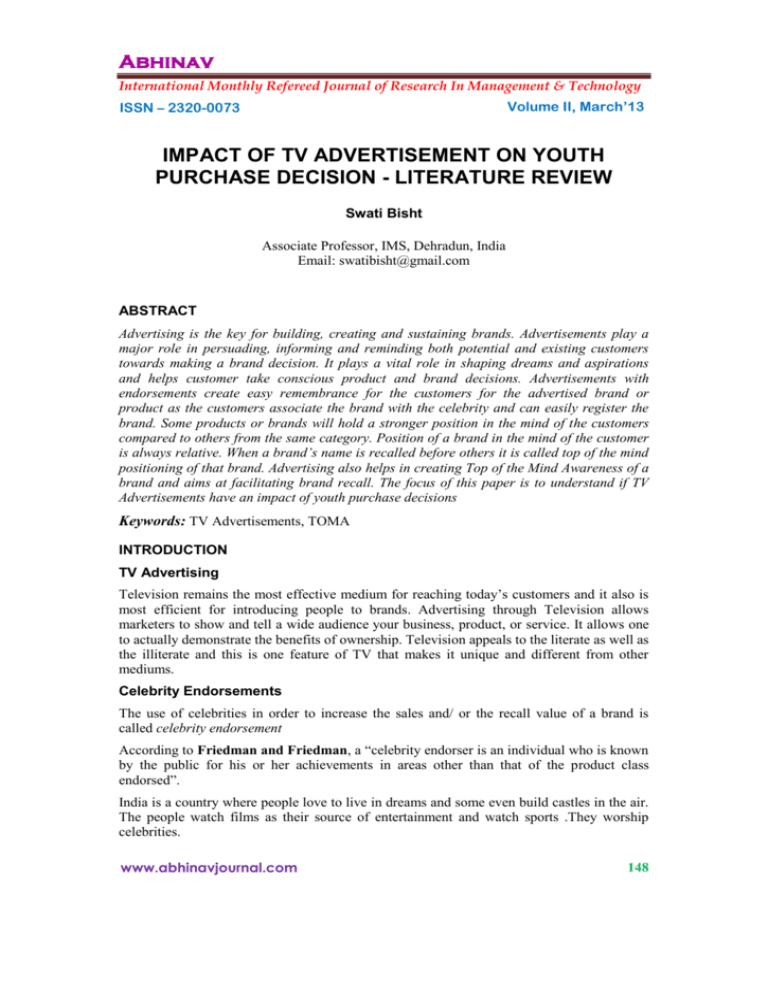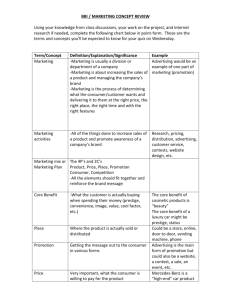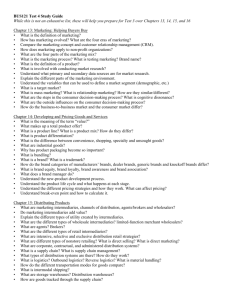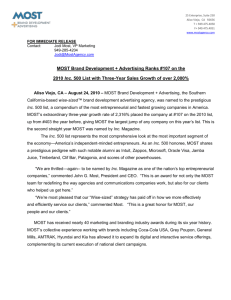Impact of TV Advertisement on Youth Purchase Decision
advertisement

Abhinav International Monthly Refereed Journal of Research In Management & Technology Volume II, March’13 ISSN – 2320-0073 IMPACT OF TV ADVERTISEMENT ON YOUTH PURCHASE DECISION - LITERATURE REVIEW Swati Bisht Associate Professor, IMS, Dehradun, India Email: swatibisht@gmail.com ABSTRACT Advertising is the key for building, creating and sustaining brands. Advertisements play a major role in persuading, informing and reminding both potential and existing customers towards making a brand decision. It plays a vital role in shaping dreams and aspirations and helps customer take conscious product and brand decisions. Advertisements with endorsements create easy remembrance for the customers for the advertised brand or product as the customers associate the brand with the celebrity and can easily register the brand. Some products or brands will hold a stronger position in the mind of the customers compared to others from the same category. Position of a brand in the mind of the customer is always relative. When a brand’s name is recalled before others it is called top of the mind positioning of that brand. Advertising also helps in creating Top of the Mind Awareness of a brand and aims at facilitating brand recall. The focus of this paper is to understand if TV Advertisements have an impact of youth purchase decisions Keywords: TV Advertisements, TOMA INTRODUCTION TV Advertising Television remains the most effective medium for reaching today’s customers and it also is most efficient for introducing people to brands. Advertising through Television allows marketers to show and tell a wide audience your business, product, or service. It allows one to actually demonstrate the benefits of ownership. Television appeals to the literate as well as the illiterate and this is one feature of TV that makes it unique and different from other mediums. Celebrity Endorsements The use of celebrities in order to increase the sales and/ or the recall value of a brand is called celebrity endorsement According to Friedman and Friedman, a “celebrity endorser is an individual who is known by the public for his or her achievements in areas other than that of the product class endorsed”. India is a country where people love to live in dreams and some even build castles in the air. The people watch films as their source of entertainment and watch sports .They worship celebrities. www.abhinavjournal.com 148 Abhinav International Monthly Refereed Journal of Research In Management & Technology ISSN – 2320-0073 Volume II, March’13 Cricket and Movies are practiced as religions in India. Celebrities which might be cricket stars like Sachin Tendulkar Sania Mirza or Film Stars like Shah Rukh Khan , Ranbir Kapoor or Katrina Kaif. The people treat them as God and give a lot of importance to what these celebrities wear, the way they talk, their statements and style of fashion. Marketers use this very preposition so as to influence their target customers may be existing or potential ones. Celebrity endorsement can play a vital leading role when it comes to leading the public’s decisions, in a market which has a vast number of local, regional, and international brands. Information and Consumer Decision Making Individual differences include consumer resources, motivation, knowledge, attitudes, and personality. Environmental influences include personal information sources, marketing forces of advertising (in-store promotions), neutral sources (booklets and pamphlets), human sources (financial consultants) and social and cultural influences (Cant et al., 2006:198). Consumer decisions are generally based on a combination of past experience and relevant information at hand.Advertising as an environmental influence impact the manner in which a consumer processes,evaluates and finally takes a decision. Top of the Mind Awareness Top-of-mind awareness (TOMA) is a company, brand or specific product coming first in customers when asked about a particular industry. The first recalled brand, product or company name (is said to have the top of the mind awareness) has a distinct competitive advantage in brand space, as it has the first chance of evaluation for purchase. TOMA is a result of various media activities that company undertakes in order to position its products / brands in the mind of the customers. Celebrities in advertisements could result in a better www.abhinavjournal.com 149 Abhinav International Monthly Refereed Journal of Research In Management & Technology ISSN – 2320-0073 Volume II, March’13 brand recall as customers of today associate with celebrities and even tend to copy them to some extent. LITERATURE REVIEW Advertising is to create understanding, liking, and selection of product or services. The most influencing theory in marketing and advertising research is attitude-towards-the-ad. However, the attitude that is formed towards the ad help in influencing consumer’s attitudes and perception toward the brand until their purchase intent (Goldsmith & Lafferty, 2002) Shiffman and Kanuk (2004) explain the meaning of “consumer behavior” as the behavior that consumer behave in the form of acquiring, buying, using, evaluating, or consuming product, service and idea to fulfill own need, and be the study of the decision making of consumer in spending resources, both money ,time and power for consuming products and services that included (1) what to buy, (2) why to buy, (3) how to buy, (4) when to buy, (5) where to buy, and (6) how often to buy. A study by Sharma (2007) finds that nowadays consumer is not easily swayed by a celebrity in an ad but he needs full fledge information about the product also, followed by brand name, overall appeal, and music/ jingle. Advertisements being endorsed by celebrities are found to be less attractive and that the use of celebrities may not change the buying behavior of consumers significantly. According to Liebeck (1998) teenagers are now more knowledgeable. They are truly the internet generation, and get their news and information primarily from television. The television medium is the most attractive and important place to advertise. Most of the young people remain glued to the television and enjoy what they see. As a wide range of products and services are consumed or used by children, many companies tend to target them (Chandok, 2005). According to traditional hierarchy-of-effects models, advertising affect of advertising exposure leads to brand cognition and cognition about the ad, which then leads to the attitude towards the ad and the brand until their purchase intent (Mendelson & Bolls, 2002). Advertisers target teenagers because of their high disposable income, their influence on parental purchases, their early establishment of loyalty to certain brands, and a conventional wisdom that they buy products on impulse (Fox 1996). Symbolic value is expected to equate the consumers’ self-image, to have an impact on individual preference, where preferences may develop for certain brands because they are perceived as reflecting their own self-image or projecting an image that they aim to possess. If the meaning of a product is not associated with the consumers’ self image, it is likely to have little influence on purchasing behavior. Saksena (1990) found that teenagers are influenced by TV advertisement and mostly purchased those brands and products which are advertised more on television. Previous studies also focus their attentions on the psychology side of advertising and they indicate how to use people’s emotions to get their attention and increase their recall of the advertisements, in the hope that this will lead to the purchase of that product in some point in time (Elliott & Speck, 1998). Heath, Brandt and Nairn (2006) in their research reveal that advertising associations attempt to accomplish three things: attention, brand awareness and persuasion. 150 www.abhinavjournal.com Abhinav International Monthly Refereed Journal of Research In Management & Technology ISSN – 2320-0073 Volume II, March’13 That is why the basic aim of advertising is to encourage people to buy things and creates awareness (Bijmolt et al., 1998). According to the traditional attitude theory consumer, behavior is predicted from consumer attitude when consumers buy the brand, which they like the most. An attitude may be defined as “acquire behavioral disposition” (Smith & Swinyard, 1983). The girl teenagers are more attracted toward TV advertisements featuring celebrities, children or jingles (Dubey & Patel, 2004).The reason for higher response rate among females for products could be the higher number of advertisements is targeted at them (Dubey & Patel, 2004). Thus, it can be said the marketers and advertisers who keep an eye on this market, must perceive opportunities to target consumers of India which is full of young generation (Selvaraj, 2007). Kaur and Kaur (2002) explored fashion awareness among rural and urban adolescents. They observed that television is the most important media of information regarding fashion awareness among rural and urban respondents. Moschis and Mitchell (1986) conducted a study designed to test the effects of television advertising and interpersonal communications on the teenager’s consumer behavior. Unlike previous studies, however, the effects of such communication processes on teens are evaluated in the context of household decision making. Thus, the influence of these images may be of enormous significance in shaping the attitudes and behaviors and attitudes of young people. Environmental variables might affect on buying behaviors of consumer (Stern, 1962). As marketing related research proposed that environment provides certain type of experience for consumer, which are used for promotion and selling product or services (Adelaar et al., 2003). When consumer views an advertisement about the brand and develops likeness for the brand and then eventually willing to purchase it (Goldsmith & Lafferty, 2002). Another component of effective advertisement that creates emotional response is the consumer ability to recall the brand ad (Goldsmith & Lafferty, 2002). Thus, the relative importance of brand recall will depend on the extent to which consumer makes product related decisions, which leads to the brand awareness (Keller, 2006) Brand knowledge through advertisement helps in influencing brand salience in a way that the quantity and sparkle of the memories about the brand thought to be in buying situation that creates emotional response towards ads (Holden & Lutz, 1992). Individuals uses cue in different buying situation for recalling the brand ad and greater chance of brand to be retrieved of any buyer, when different attributes are attached to the brand, which creates brand association (Romaniuk & Sharp, 2004). CONCLUSION The literature review suggests that there is a positive relation between TV Advertising and youth purchase and that there is positive relationship of emotional response with consumer buying and TV Advertisements. Therefore, it is concluded that consumers purchase products by emotional response, rather that environmental response.. TV advertising impact on buying behavior of teenagers related to different residential backgrounds (i.e., rural and urban) and gender groups (i.e., male and female). Advertisements on TV have an impact on the trial of the product by the customer. www.abhinavjournal.com 151 Abhinav International Monthly Refereed Journal of Research In Management & Technology ISSN – 2320-0073 Volume II, March’13 REFERENCES 1. Adelaar, T., Chang, S., Lanchndorfer, K. M., Lee B. & Morimoto M. (2003). Effects of Media Formats on Emotions & Impulse Buying Behavior. Journal of Information Technology, 18, 247–266.s 2. Agrawal and Kamakura, Wagner A., (1995), “The economic worth of celebrity endorsers: An event study analysis,” Journal of Marketing, Chicago, Vol. 59, Iss. 3; pg. 56-63. 3. Bahram Ranjbarian (2010) ‘Celebrity Endorser Influence on Attitude Toward Advertisements and Brands’ European Journal of Social Sciences – Volume 13, Number 3 399-407 4. Bauer, R. A. and Greyser, S. A. (1968). “Advertising in America: The Consumer View”. Boston: Harvard University. 5. Bijmolt, T. H. A., Claassen, W. & Brus, B. (1998). Children are Understanding of TV Advertising: Effect of Age, Gender, and Parental Influence. Journal of Consumer Policy, 21, 171-194. 6. Cant, M. & Machado, R. (2004) Marketing success stories. Fifth edition. Oxford University Press 7. Chan, K. (2001), “Children’s perceived truthfulness of television advertising and parental influence: a Hong Kong study”, in Gilly, M.C. and Meyers-Levy, J. (Eds), Advances in Consumer Research, Vol. 28, pp. 207-12. 8. Cooper, M.(1984). Can Celebrities Really Sell Products? Marketing and Media Decisions, 19(September), 64-65. 9. Dean, D.H. and Biswas, A. (2001). Third Party Organization Endorsement of Products: An Advertising Cue Affecting Consumer Pre-purchase Evaluation of Goods and Services. Journal of Advertising, 30(4), 41-57. 10. Elliot, M.T., & Speck, P.S. (1998). Consumer perceptions of advertising clutter and its impact across various media. Journal of Advertising Research, 38 (1), 29-41. 11. Fox, R.F. (1996), Harvesting Minds: How TV Commercials Control Kids,New Haven, CT: Praeger. 12. Gentry, J.W. and Doering, M. (1977). Masculinity-Femininity Related to Consumer Choice. In B. A. Greenberg and D. N. Bellinger (Eds.), Contemporary Marketing Thought (pp. 423-427). Chicago, IL: American Marketing Association 13. Holden, S. J. S. & Lutz, R. J. (1992). Ask Not What the Brand Can Evoke; Ask What Can Evoke the Brand. Journal of Advances in Consumer Research, 19, 101 -107. 14. Kaur, H. and Kaur, R. (2002) “Fashion Awareness Among Rural and Urban Adolescents”, Journal of Social Research, Vol. 43, No. 1, pp. 37-40. 15. Keller, L. K. (2006). Strategic Brand Management Process, in Prespective of Modern Brand management, Ed. Dr. Franz-Rudolf Esch. 16. Khatri, P. (2006), “Celebrity Endorsement: A Strategic Promotion Perspective”, Indian Media Studies Journal Vol.1 No.1. July-Dec. www.abhinavjournal.com 152 Abhinav International Monthly Refereed Journal of Research In Management & Technology ISSN – 2320-0073 Volume II, March’13 17. Kotwal Nidhi, Gupta Neelima and Devi Arjee (2008) “Impact of T.V Advertisements on Buying Pattern of Adolescent Girls”, Journal of Social Sciences, Vol. 16, No. 1, pp. 5155. 18. McCracken, G., (1989), “Who is the Celebrity Endorser? Cultural Foundations of the Endorsement Process”, Journal of Consumer Research, Volume 16 December, pp. 310 – 321 19. Mendelson, A. L. & Bolls, P. D. (2002). Emotional effects of advertising on young adults of lower socio economicstatus. Retrieved on Dated: 01-05-2009. 20. Moschis, G. P. and Mitchell, L. G.(1986), “ Television Advertising and Interpersonal Influences on Teenagers Participation in Family Consumer Decisions”, Advances in Consumer Research, Volume 13, Pages 181-186 21. Pollay, R. W., Mittal, B. (1993): Here’s the Beef: Factors, Determinants and Segments in Consumer Criticism of Advertising, Journal of Marketing, 57 (3): 99-114 22. Romaniuk, J. & Sharp, B. (2004). Conceptualizing & Measuring Brand Salience. Marketing Theory Articles, 4(4), 327-342. 23. Schiffman, L.G. and Kanuk, L.L., 2004. Consumer Behavior (8th ed.). Upper Saddle River, NJ: Pearson. 24. Sharma Sandhir (2007), “Celebrities don’t affect consumer decision making, says study”, from www.indianmba.com/Faculty Column 25. Silvera, D. H. and Austad, B. (2004), “Factors predicting the effectiveness of celebrity endorsement advertisements”, European Journal of Marketing 38 (11/12): 1509–1526. 26. Smith, R. E. & Swinyard W. R. (1983). Attitude- Behavior Consistency: The Impact of Product Trial versus Advertising. Journal of Marketing Research, 1, 257-267 27. Stern, H. (1962). The Significance of Impulse Buying Today. Journal of Marketing, 26, 59-62. 28. Surana, R. (2008), “The Effectiveness of Celebrity Endorsement in India”, A dissertation presented in part consideration for the degree of MA in Marketing. 29. Vitz, P.C. and Johnston, D. (1965). Masculinity of Smokers and the Masculinity of Cigarette Images. Journal of Applied Psychology, 49(3), 155-160. 30. Goldsmith, R. E. & Lafferty, B. A. (2002). Consumer response to websites & their influence on advertising effectiveness. Internet research. Journal of Electronic Networking Application and Policy, 12(4), 318-328. www.abhinavjournal.com 153









